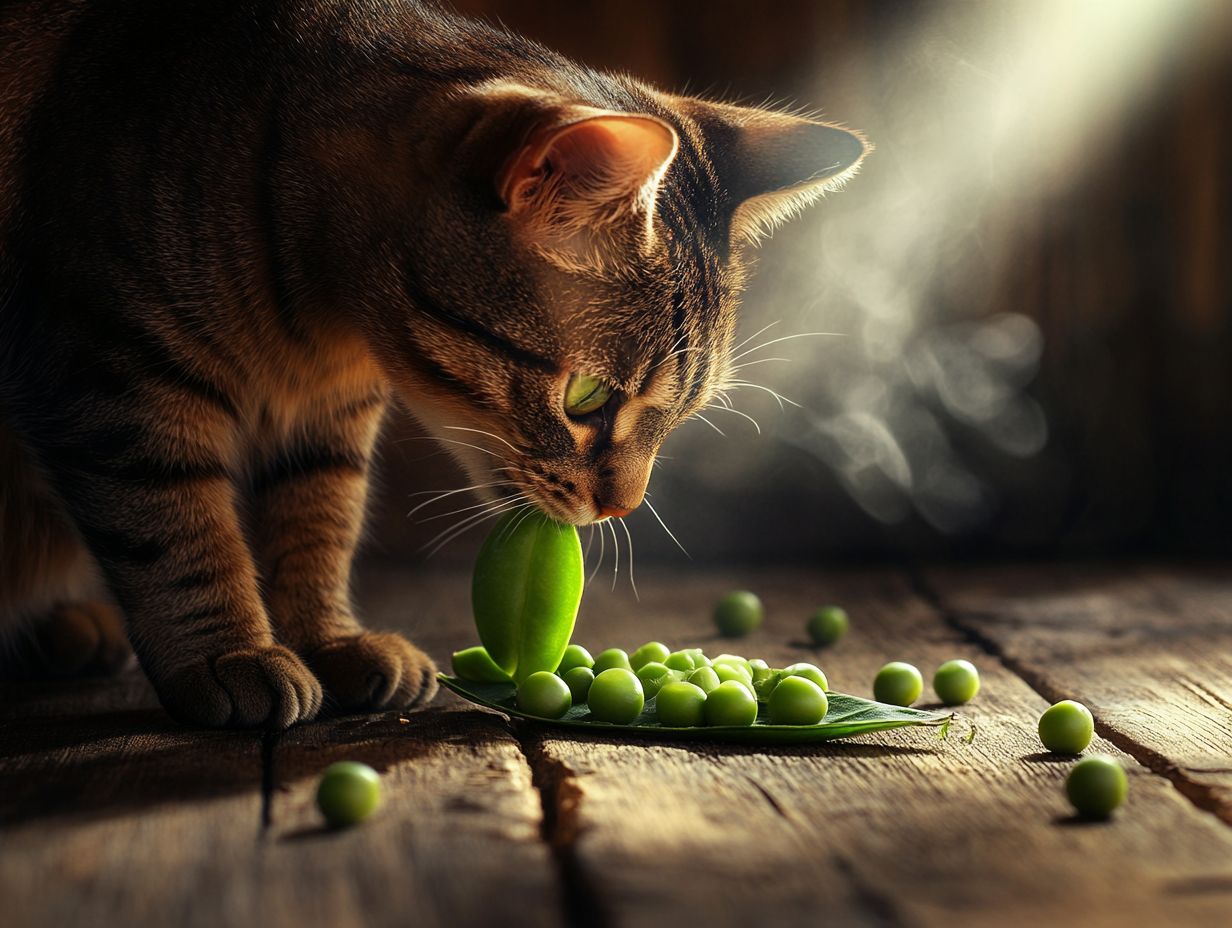Are you a cat owner wondering if you can share your favorite green peas with your furry friend? The good news is that yes, in moderation, green peas can be a nutritious addition to your cat’s diet. However, it’s essential to understand both the benefits and risks involved. Many cat owners question whether green peas—such as English Peas, Snow Peas, or Sugar Snap Peas—are safe for their pets.
While these vibrant legumes may seem harmless, comprehending their nutritional value and potential risks is crucial. This article explores the benefits, types, and safe incorporation of green peas into your cat’s diet to enhance overall health, while providing alternatives for a balanced meal.
Key Takeaways:
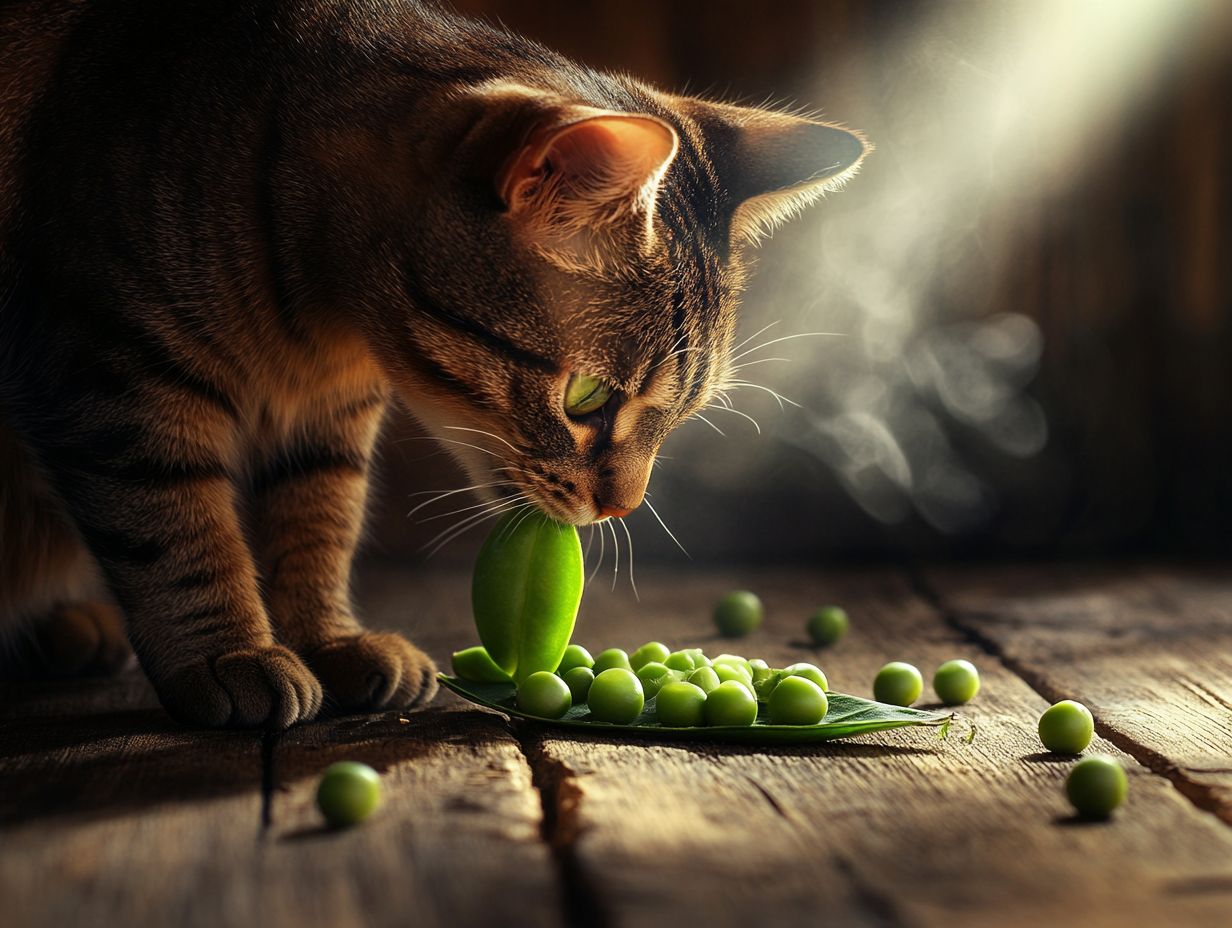
Are Green Peas Safe for Cats?
It is vital for cat owners to understand whether green peas are safe for their pets, particularly those aiming for a well-balanced diet. While cats primarily eat meat, incorporating appropriate vegetables in small amounts can be beneficial.
Green peas are among the most popular vegetables considered for feline diets, warranting an examination of their safety and impact on well-being. You should consult with a veterinarian to get tailored advice about your cat’s individual health needs.
Benefits and Risks of Green Peas for Cats
The pros and cons of feeding green peas to cats revolve around the health benefits and potential negative effects, such as digestive upset and obesity.
Pros of Green Peas for Cats: Nutritional Benefits
Green peas offer essential vitamins that contribute to a cat’s overall health. They are rich in Vitamin A, which helps maintain healthy skin, and various B vitamins vital for numerous bodily functions. Additionally, they provide fiber that aids digestion, making them particularly helpful in preventing constipation. Other nutrients like zinc and iron also enhance their nutritional profile.
Cons of Green Peas for Cats: Risks Associated with Consumption
However, risks exist. Overconsumption can lead to weight gain or obesity, which pose serious health risks. Signs of overconsumption may include bloating or changes in stool consistency, leading to diarrhea or discomfort for the cat. Monitoring regular intake is crucial.
Nutritional Value of Green Peas for Cats
Green peas provide a range of nutritional components that are beneficial when included in a balanced diet. They are rich in protein and carbohydrates, contributing to overall health.
Moreover, they contain vital vitamins such as A, B, C, and K, along with minerals like iron and zinc, all of which are essential for a cat’s well-being. The high fiber content in green peas can also aid digestion and support healthy weight management.
Vitamins and Minerals Found in Green Peas
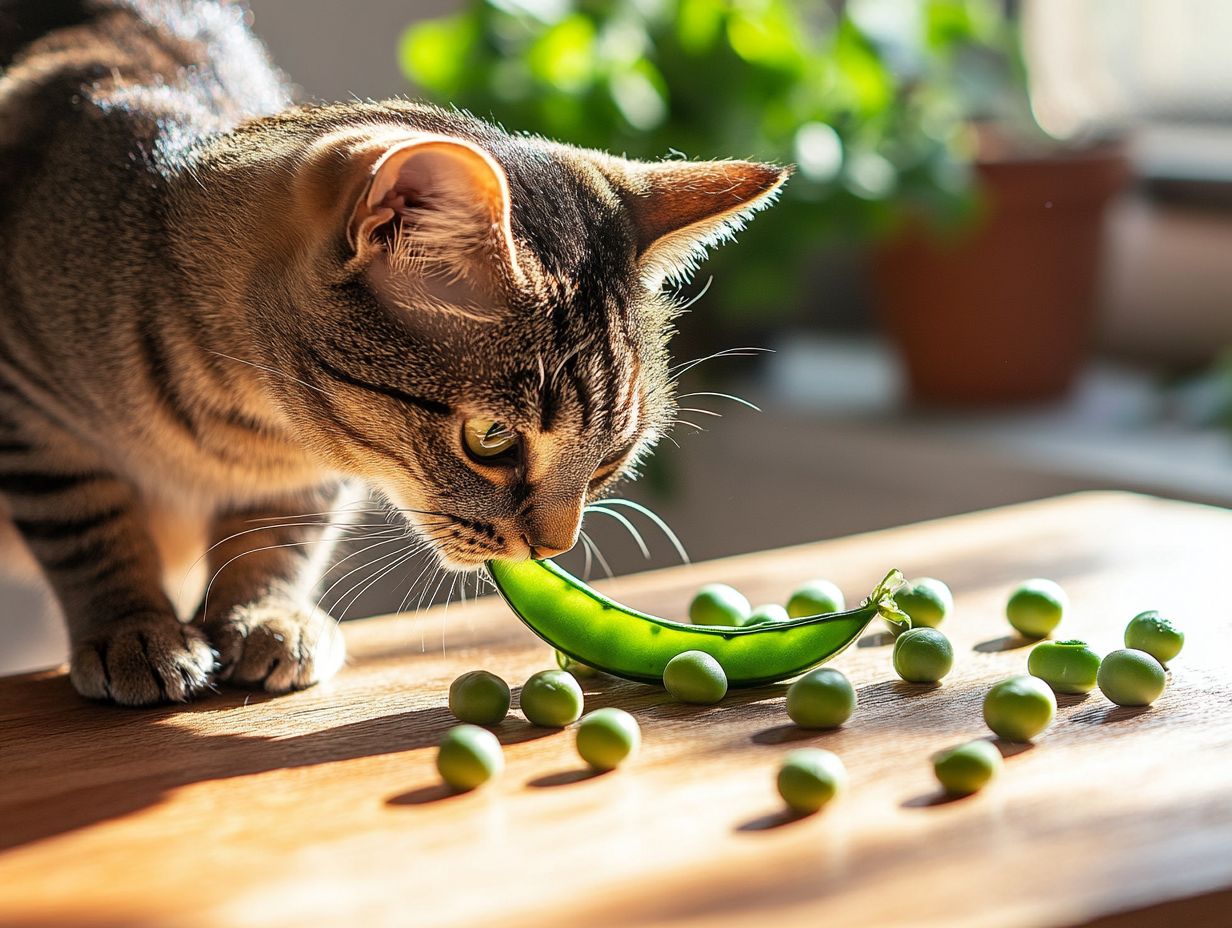
Green peas are replete with a variety of vitamins and minerals that contribute to a cat’s health. They contain vitamins A, C, and K, enhancing the immune system and supporting vision.
Additionally, they provide essential minerals like manganese and potassium, promoting bone and muscle health. They also offer fiber that aids digestion, along with antioxidants to help prevent oxidative stress, promoting longevity.
Some cats may have allergies to legumes. Always consult your veterinarian if you have concerns about adding green peas to your cat’s diet.
In conclusion, while green peas can be a healthy treat for cats, it’s critical to consult your veterinarian for personalized advice. For more information on the safety and nutritional value of green peas, refer to trusted veterinary sources.
Feeding green peas to cats can offer potential benefits, such as supporting vitality and adding essential nutrients to their diet. However, be mindful of risks like digestive upset. Always consult your veterinarian, such as Dr. Linda Simon or Leslie Ingraham, for personalized advice.
Benefits of Green Peas
Green peas support a cat’s vitality, reduce the risk of chronic diseases, and contribute to a balanced nutritional profile. They are a good source of fiber, vitamins A, C, and K, along with minerals like iron and magnesium.
Risks of Feeding Green Peas
While green peas can be beneficial, they should be given in moderation. Symptoms of digestive upset include vomiting, diarrhea, and abdominal discomfort. Always monitor your cat closely after introducing new foods.
How to Incorporate Green Peas into a Cat’s Diet
Feeding cats green peas can be safe and effective if pet owners understand the appropriate quantity and form to offer these vegetables. While cats primarily require protein from meat sources, small portions of vegetables like peas can add essential nutrients to their diet.
It’s crucial to prepare peas properly—cook them without salt or seasonings—and offer them in moderation to prevent digestive upset or other health issues. For a 10-pound cat, offer 1 to 2 teaspoons of cooked green peas. Regular monitoring and consultation with a veterinarian are advised.
Proper Serving Sizes and Preparation Methods
Green peas should be offered in limited amounts and only when properly prepared to minimize digestive issues. The appropriate serving size is determined by factors like the cat’s weight, age, and overall health.
Younger, more active cats may tolerate slightly larger servings than older, less active cats. To maintain the peas’ nutritional value, either steam or lightly boil them to help preserve vitamins and make them easier to digest.
As with any significant dietary change, it’s essential to consult your veterinarian for recommendations tailored to your cat’s specific needs.
Alternatives to Green Peas for Cats
Green peas are not the only food that can enhance a cat’s diet. There are many alternatives that can also positively influence health and nutrition.
Other Nutritious Foods to Consider
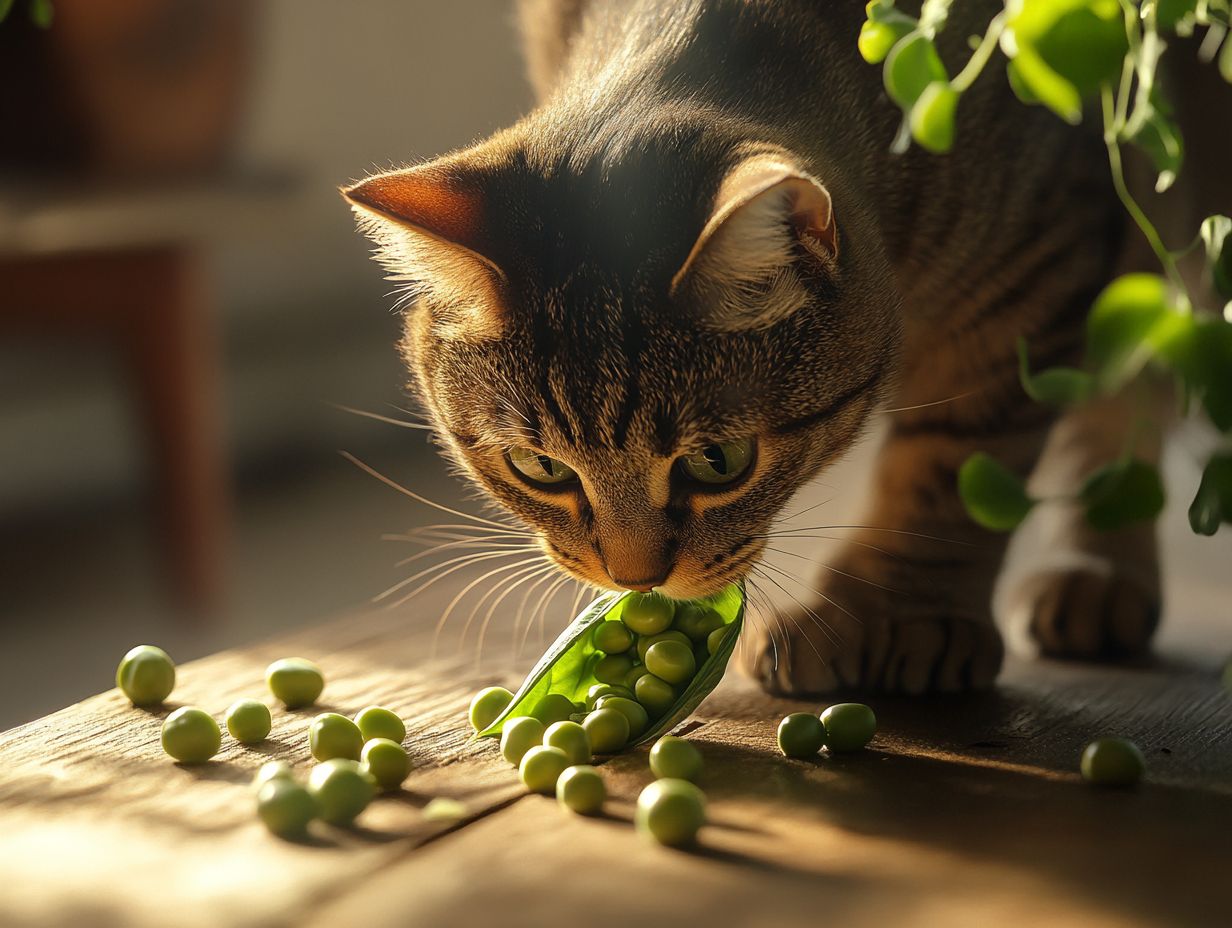
Numerous healthy foods beyond green peas can provide added health benefits for cats. Although cats do not require vegetables in their diet, incorporating a variety can offer essential nutrients, vitamins, and minerals. Alternatives like carrots, sweet potatoes, and the Everlasting Pea Plant can be nutritious additions.
For instance, carrots are rich in beta-carotene for improved eyesight, while sweet potatoes are high in fiber and antioxidants that support digestion. Leafy greens like spinach and kale are beneficial for their key vitamins and minerals, but should only be given in moderation, as excessive amounts can lead to health issues. If you’re curious about whether cats can eat other greens, check out this Nutritional Guide on Cats and Green Peas.
It’s important to note that certain vegetables, like onions and garlic, can be toxic to cats, so caution is warranted. Always consult a veterinarian before making significant dietary changes to ensure the vegetables align with your cat’s health needs.
Frequently Asked Questions
For more insights into balanced diets, consult veterinarians like Dr. Linda Simon or Leslie Ingraham.
Can cats eat green peas?
Yes, cats can eat green peas in small quantities.
Are green peas nutritionally beneficial for cats?
Yes, green peas are a good source of fiber, as well as vitamins A, C, and K, along with minerals like iron and magnesium for cats.
Can green peas be harmful to cats?
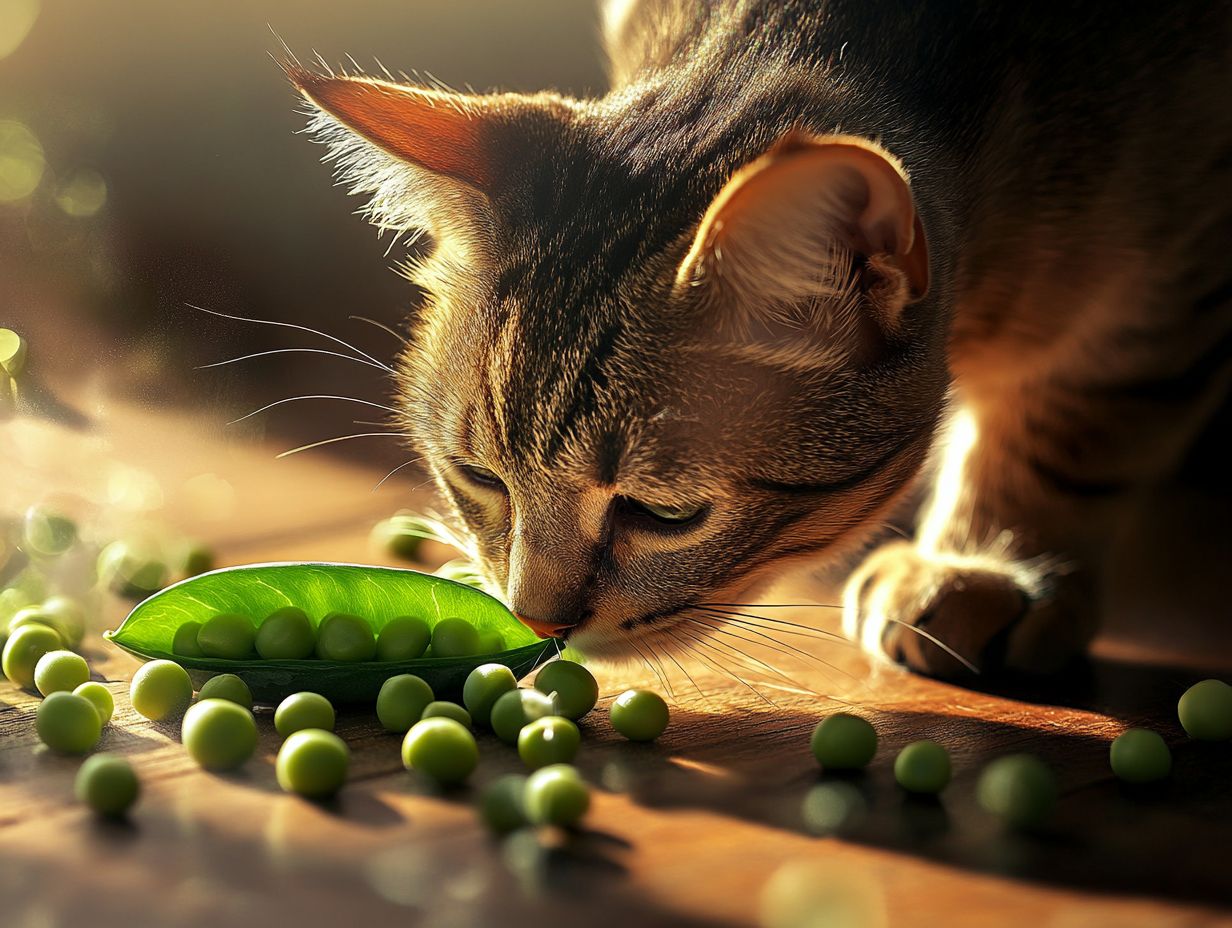
In large amounts, green peas can cause digestive issues in cats, such as vomiting and diarrhea, hence they should be given in moderation.
How should green peas be prepared for cats?
Green peas should be cooked without salt or seasonings before being given to cats. Raw peas can be difficult for them to digest.
Can cats eat canned green peas?
Canned green peas often have added salt and preservatives, which can be harmful to cats. Therefore, it is not recommended to feed them to cats.
How many green peas can cats eat at a time?
It is recommended to give cats no more than 10% of their daily caloric intake in green peas, which varies based on the cat’s size and diet.
Conclusion
Incorporating green peas in moderation can benefit your cat’s diet, but always be cautious of potential risks. Regular consultation with a veterinarian is essential to ensure safe feeding practices. Here’s a checklist for safe practices:
- Introduce new foods gradually.
- Monitor for signs of digestive upset.
- Consult your veterinarian for tailored guidance.
